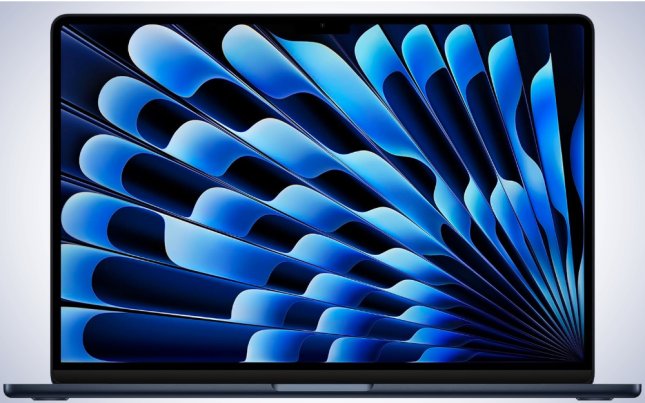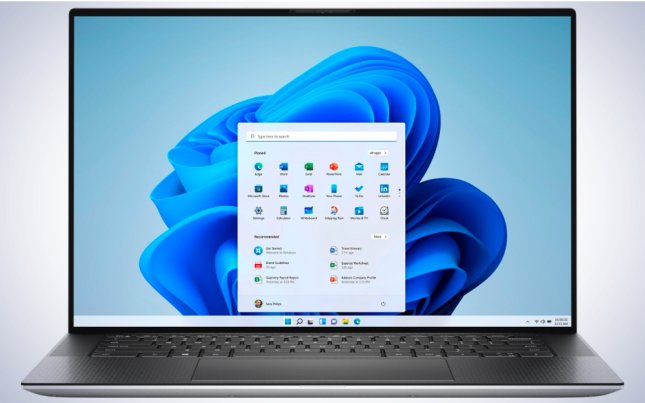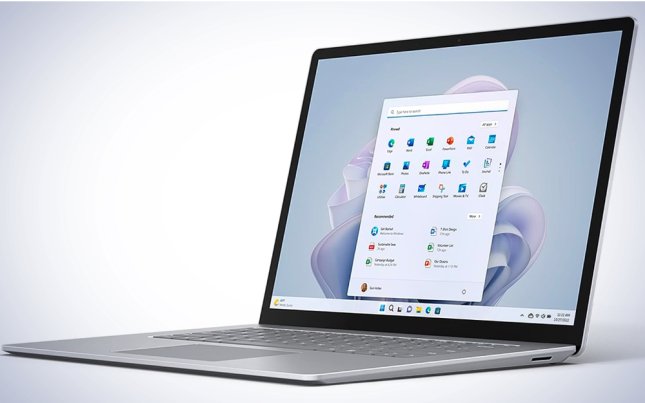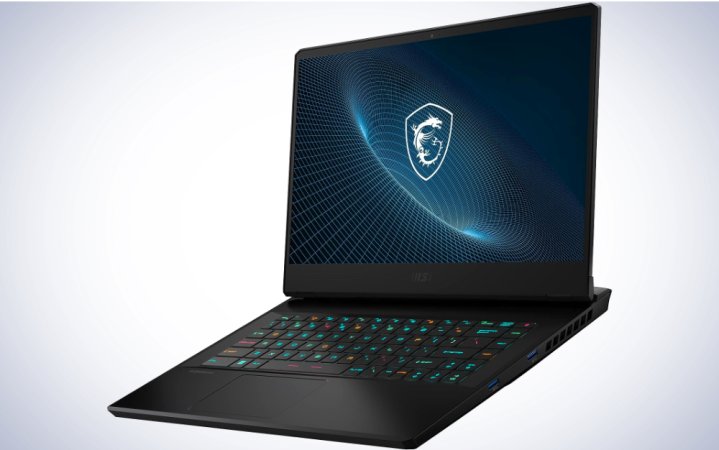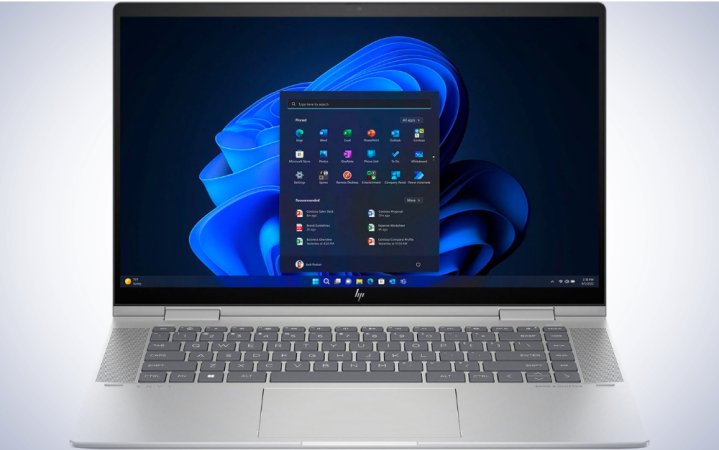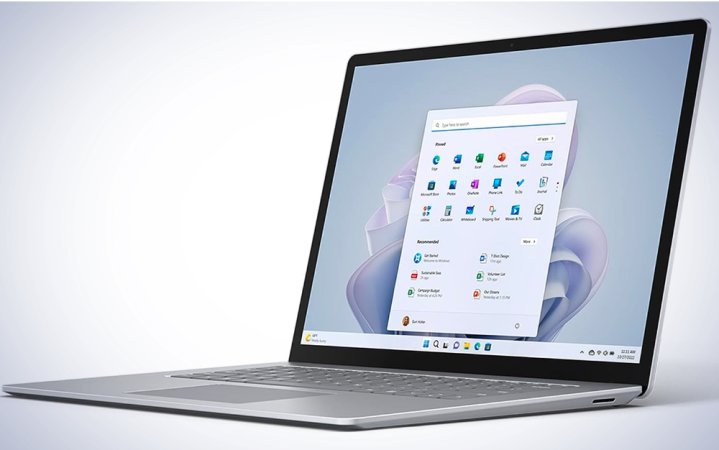We may earn revenue from the products available on this page and participate in affiliate programs. Learn more ›

Today’s 15-inch laptops perfectly balance portability and performance while offering a trifecta of benefits: ample screen real estate, a comfortable typing experience, and superior hardware, setting them apart from smaller models. This blend of versatility and capability makes laptops of this size an attractive computing solution. The larger display enhances productivity and immerses you in a rich multimedia experience. At the same time, the powerful hardware configurations enable seamless multitasking, all within a compact design that’s easy to transport. This combination of features provides the ideal platform to tackle an array of tasks, from web browsing and emailing to content creation, rendering the best 15-inch laptops a compelling choice for those seeking the best of both worlds.
- Best overall: MacBook Air with M2
- Best for gaming: MSI Vector GP66
- Best touchscreen: Dell XPS 15
- Best under $1,000: HP Envy x360 2-in-1
- Best budget: Microsoft Surface Laptop 5
How we chose the best 15-inch laptops
As someone who regularly works in coffee shops, libraries, and co-working spaces, I know the importance of selecting the right laptop for remote work. When away from your desk, you need a device that can handle various tasks, from editing pictures and videos to data analysis. My experience with the demands and nuances of remote work has given me valuable insight into what to look for in the best 15-inch laptops. Additionally, I’ve written about and tested laptops for publications like Popular Science, Best Products, and Forbes. Drawing from my extensive experience and expertise, I assessed these laptops based on factors like performance, design, portability, battery life, and affordability.
The best 15-inch laptops: Reviews & Recommendations
Whether you’re a professional seeking powerful processing capabilities or a student on a budget, this guide will highlight models that suit different needs and financial constraints. These laptops span the gamut regarding power, display quality, and design, giving you options that align with your requirements. Do you prioritize multitasking or a high-resolution display? Our list of the best 15-inch laptops will ensure you find the model that delivers the features you need to get work done, whether you’re working from home or in an office.
Best overall: MacBook Air with M2
MacBook Air with M2
Pros
- Lightweight
- Beautiful high-resolution display
- Fantastic performance
Cons
- Base model storage can fill up fast
Specs
- Display: 15.3-inch Liquid Retina
- Processor: Apple M2 with 8-core CPU, 10-core GPU, 16-core Neural Engine
- Memory: 8GB
- Storage: 256GB
The biggest MacBook Air to date is also the best, offering a beautiful display, powerful performance, and a sleek, lightweight design. The laptop features Apple’s latest in-house M2 processor, which offers an 8-core CPU, 10-core GPU, and 16-core Neural Engine. The resulting performance is impressive, nipping on the heels of Apple’s MacBook Pro with M2 chip. While the Air is targeted at everyday computing (e.g., working on documents, browsing the web, emailing), it can handle more intensive tasks like editing photos, videos, and graphics.
`
The MacBook Air with M2 is 0.45 inches thick and weighs 3.3 pounds, making it easy to transport around campus or to a coffee shop. A six-speaker sound system offers excellent audio performance, and the 2880 x 1864 resolution screen looks phenomenal when streaming movies. The laptop also features a spacious keyboard with Touch ID and an expansive trackpad that supports multi-touch gestures. It all comes in the best design in Apple’s lineup, with up to 18 hours of battery life, making the MacBook Air with M2 the best overall 15-inch laptop available.
Best for gaming: MSI Vector GP66
Pros
- Lightning-fast performance
- Ultra-high refresh rate display
- 32GB of memory
Cons
- Loud fan noise
Specs
- Display: 15.6-inch 1080p
- Processor: Intel 12th Generation Core i9
- Memory: 32GB
- Storage: 1TB
The MSI Vector GP66 earned a spot on our list of the best gaming laptops, and it’s making an appearance on this list, too. The gaming laptop boasts Intel’s powerful 12th-generation Core i9 processor, which features six performance cores and eight efficiency cores, plus the Nvidia GeForce RTX 3070 Ti GPU. The result is smooth, rapid performance that can easily handle the latest AAA titles, including Bethesda’s Starfield. Unsurprisingly, this is the most rugged laptop, given its thicker body, which accommodates the more energy-hungry specs required for gaming.
This particular model features 32GB of RAM and a 15.6-inch 1080p display. While the screen isn’t 4K, the lower resolution means you can play titles with more detailed graphics at higher frames per second. And it opens the door to advanced features like DLSS upscaling to improve gaming performance further. Our only qualm is the fans inside the MSI can get loud when it’s pushed to its limits. It’s something that doesn’t happen often, but it’s worth noting if you plan to game in a quiet environment. Still, for a gaming PC in laptop form, it’s hard to beat MSI’s Vector GP66.
Best touchscreen: Dell XPS 15
Pros
- Beautiful touchscreen
- Sturdy, elegant design
- Good battery life
Cons
- 720p webcam
- No USB-A ports
Specs
- Display: 15.6-inch FHD+
- Processor: Intel 12th Generation Core i7
- Memory: 16GB
- Storage: 512GB
Our favorite Windows laptop deserves a spot on our list of the best 15-inch models. Dell has several laptops that are hard to beat, and the XPS line, in particular, is a favorite across the industry, offering excellent performance, portability, and design. The XPS 15, updated for 2023, rocks a 12th-generation Intel Core processor i7 (there are i5 and i9 configurations), up to 64GB of RAM, and a 15.6-inch FHD+ touchscreen.
The XPS 15 can be upgraded with a high-end NVIDIA graphics card, giving you plenty of power to play games and edit high-resolution videos. You can also configure the device with up to 8TB of SSD storage, which is plenty for applications, games, images, and video. There are two Thunderbolt 4 USB-C ports, a USB 3.2 Type-C port, and a built-in SD card reader. Other configuration options include a Full HD Plus (1920×1080) non-touch display and an Ultra HD Plus (3849×2400) touch display.
All said, the XPS 15 is the closest challenger to Apple’s M2-equipped MacBook Pro in terms of performance and design, and there are several configuration options to meet specific needs.
Best under $1,000: HP Envy x360 2-in-1
Pros
- Port selection
- Sleek design
- 2-in-1 functionality
Cons
- Low-resolution display
Specs
- Display: 15.6-inch Full HD
- Processor: Intel 13th Generation Core i7
- Memory: 16GB
- Storage: 1TB
The HP Envy x360 features a 2-in-1 hybrid design that lets you switch from laptop mode to tablet mode. The display hinge makes it easy to switch between the two and tailor the experience to your preferences—laptop mode for work and tablet mode for streaming videos. The display is decidedly low resolution at 1080p, but it keeps the price under $1,000, a worthwhile sacrifice in our book.
While the display is stuck at 1080p, the Envy X360 offers a good balance of design and performance, with an Intel 13th Generation Core i7 chip, 16GB of RAM, and 1TB of storage. This configuration also features Intel Iris Xe graphics, so you should be able to play your favorite games—but don’t expect to run the latest AAA titles on high settings. There is an HDMI 2.1 port, two Thunderbolt 4 (USB-C) ports, two USB-A 3.1 ports, and an SD card reader. If you’re just beginning your content creation journey, the Envy is an excellent option, and HP makes other quality laptops worth exploring.
Best budget: Microsoft Surface Laptop 5
Pros
- Excellent battery life
- Sleek, lightweight design
- Beautiful display
Cons
- 720p webcam
Specs
- Display: 15-inch
- Processor: Intel 12th Generation Core i7
- Memory: 8GB
- Storage: 256GB
Microsoft’s Surface Laptop 5 is an excellent option for those on a budget. The device features a premium aluminum build (unchanged from the Surface Laptop 4), with dimensions of 0.58 x 13.4 x 9.6 (HWD) and 3.4 pounds. The design is very much in the vein of the MacBook Air with M2, with a minimalist look that feels very high quality. And it’s available in a few colors, including platinum and black.
The 15-inch display offers a 3:2 aspect ratio and a crisp 2496 x 1664 resolution, so movies and other media look detailed. There are two ports—one USB-C (Thunderbolt 4) and one USB-A, giving you some flexibility to use different peripherals. There’s also a headphone jack, which is worth mentioning since the port is slowly disappearing from portable electronics. As a budget device, the Surface Pro 5 offers high-quality construction, excellent performance, and long-lasting battery life.
For those on more of a budget, the Surface Laptop 4 is still available. However, you may sacrifice longevity since the device is already a few years old.
What to consider when selecting one of the best 15-inch laptops
The good news is several excellent laptops in this size range cater to different preferences and budgets. We’ve rounded up the best options, whether your goal is content creation or hardcore gaming.
Processor
The brain of your laptop is the Central Processing Unit, or CPU. Modern Apple laptops feature the brand’s M1 or M2 system-on-a-chip. These processors (also available on Apple’s iPad Pro models) combine the CPU, graphics processing unit (GPU), security enclave, neural engine, and shared memory on a single piece of silicon. Meanwhile, newer Windows laptops generally feature either 12th or 13th Generation Intel Core i5 or i7 processors, offering 6 or 8 processor cores.
To gauge a laptop’s computing power, it’s essential to consider its clock speed, measured in GHz, and the number of CPU cores. A processor with higher clock speeds and more CPU cores can perform tasks more rapidly and is well-suited for users engaging in resource-intensive activities such as high-resolution video editing. We recommend investing in a laptop with a robust CPU if your work involves multitasking, gaming, or content creation, as it’s not typically possible to upgrade the processor after purchase.
Graphics
The GPU is another critical component, one responsible for handling graphics-related tasks. It works alongside the CPU to render and display graphics on the screen, encompassing everything from visual rendering to gaming and video playback. Laptops either feature an integrated or dedicated GPU; integrated graphics, like those from Apple, find the GPU included on the same chip as the CPU.
Laptops dedicated to gaming generally feature dedicated graphics cards with their own memory. However, it’s important to note that laptops with dedicated graphics tend to be bulkier and heavier, impacting their portability. Additionally, due to the increased power demand of dedicated GPUs, users may need to be more vigilant about monitoring their laptop’s battery life throughout the day.
Memory
Your computer’s Random Access Memory, or RAM, is integral to your laptop’s performance. RAM provides applications with a place to temporarily store and access data. If you multitask, you’ll want a laptop with more RAM—at least 8GB for more basic tasks or 16GB if you use creative apps. The more memory your laptop has, the faster it will complete tasks. Laptops typically don’t allow users to upgrade memory after the fact, so you may be stuck with the configuration you buy.
Display
When evaluating a laptop’s display, there are several things to consider. Screen resolution is one significant aspect to examine. Many of today’s best 15-inch laptops feature a 4K (3840×2160) display, offering sharper visuals that allow you to see more minor details in your photos and videos. More affordable models feature a 1080p (Full HD) display that’s fine for general use like web browsing, emailing, and school work.
Equally important is the display technology, with options including IPS for wider viewing angles or OLED for vibrant contrast. Some gaming laptops also feature high-refresh-rate panels for smoother animations. Accurate color representation is also essential for creative work, allowing you to achieve true-to-life visuals in your images and videos. For reliable color accuracy, aiming for a screen that covers at least 90% to 100% of the sRGB color gamut is advisable.
Some laptops support DCI-P3, which provides approximately 26% more color space than sRGB. This extended color range allows for more vivid and saturated colors, making it an excellent choice for tasks that demand vibrant imagery, such as professional photo and video editing.
Storage
Solid-state drives (SSD) have become the standard for data storage, employing more advanced technology than traditional hard drives. SSDs feature no moving parts, enhancing their speed and reliability. The absence of mechanical components results in quicker data access, leading to faster file and application loading times, a feature convenient for gaming and content creation.
For most users, a laptop with a 256GB SSD is a sound choice, offering a good balance between performance and storage capacity. However, it’s essential to remember that data accumulates over time, so upgrading to a 512GB or even a 1TB SSD can be a wise investment if it’s within your budget. Alternatively, consider using portable hard drives for additional storage, which provides flexibility in managing large files and backups.
Connectivity
The ports on a laptop can expand its functionality. Traditional USB-A ports were once the industry standard and still serve a vital purpose. Still, high-bandwidth ports like USB-C and Thunderbolt 4 are becoming more common. These ports enable rapid data transfer, making importing and exporting media more efficient and convenient. An HDMI port allows you to connect your laptop to an external display, and a built-in card reader is handy for transferring media from cameras or memory cards.
You can use a USB hub to extend your laptop’s connectivity options if it doesn’t have all the necessary ports. However, built-in ports provide the most seamless and hassle-free experience, eliminating the need for additional accessories and simplifying your work setup. When choosing a laptop, consider the types and quantity of ports it offers to ensure they align with your requirements.
FAQs
No, a 15-inch laptop isn’t too big. That said, its suitability largely depends on your specific needs. The larger display can enhance productivity for content creation, programming, or multitasking tasks. It can also provide a more immersive experience when gaming or watching movies. A larger display may not be necessary for basic tasks, including web browsing and emailing. The trade-off for a 15-inch laptop is a compromise in portability—it will be heavier and take up more space in your bag and on your desk. If you can manage the larger size, a 15-inch laptop isn’t too big.
Yes, a 15-inch laptop is good for gaming. This size is more or less the standard for gaming laptops, giving you the perfect balance of size and portability. That said, there is no best screen size for a gaming laptop; it comes down to what aligns with your preferences. There are gaming laptops with 17-inch displays, giving you an experience closer to a traditional desktop and monitor setup. Our guide to the best gaming laptops goes over different screen sizes in-depth, finding that 15 inches is the sweet spot.
Ideally, sitting about an arm’s length away or a distance of approximately 18 to 24 inches would be best. This will give you a clear view without straining your eyes. If you’re anything like me, there may be times when you sit a little closer, like when you’re gaming, watching a movie, or editing details in a photo or video. The optimal distance will depend on your activity and comfort level. It’s important to remember that you should take regular breaks to help combat eye strain. It can be as simple as walking around your home for five minutes or looking at something in the distance for a short period.
Yes, you can bring a 15-inch laptop onto a plane in your carry-on luggage. The whole purpose of a laptop is its portability, and a plan is a common place for travelers to work. Tray tables in standard airline flights can generally accommodate laptops, including 15-inch models. Remember, you will likely have limited space to work, so you may not have room for additional accessories, including a mouse. To ensure a smooth experience, check with the airline or consult their website to see if they provide specific dimensions or guidelines for electronics usage on your flight. We also recommend stowing your laptop in a well-padded case or bag when you travel for protection.
Final thoughts on the best 15-inch laptops
- Best overall: MacBook Air with M2
- Best for Gaming: MSI Vector GP66
- Best Touchscreen: Dell XPS 15
- Best Under $1,000: HP Envy x360 2-in-1
- Best budget: Microsoft Surface Laptop 5
The MacBook Air with M2 is the best 15-inch laptop, featuring an impressive balance of power and portability. It’s on the expensive side for casual use, but it should last for years. It offers many of the MacBook Pro’s best features, including Touch ID, MagSafe charging, and a comfortable scissor-switch keyboard. If the MacBook Air with M2 isn’t your jam, options are abundant in this size range. All of our picks are worthy of your consideration, and what you choose comes down to your preferences and budget. Whether you’re a creative professional seeking top-notch performance or a student looking for a reliable and stylish companion for the semester, the MacBook Air with M2 offers a compelling choice that bridges the gap between power and convenience, making it a versatile option at this size.
